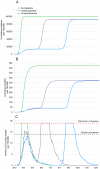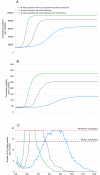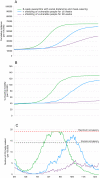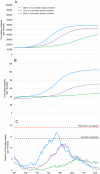This is a preprint.
Lockdown exit strategies and risk of a second epidemic peak: a stochastic agent-based model of SARS-CoV-2 epidemic in France
- PMID: 32511469
- PMCID: PMC7255789
- DOI: 10.1101/2020.04.30.20086264
Lockdown exit strategies and risk of a second epidemic peak: a stochastic agent-based model of SARS-CoV-2 epidemic in France
Update in
-
A stochastic agent-based model of the SARS-CoV-2 epidemic in France.Nat Med. 2020 Sep;26(9):1417-1421. doi: 10.1038/s41591-020-1001-6. Epub 2020 Jul 14. Nat Med. 2020. PMID: 32665655
Abstract
Most European countries have responded to the COVID-19 threat by nationwide implementation of barrier measures and lockdown. However, assuming that population immunity will build up through the epidemic, it is likely to rebound once these measures are relaxed, possibly leading to a second or multiple repeated lockdowns. In this report, we present results of epidemiological modelling that has helped inform policy making in France. We used a stochastic agent-based microsimulation model of the COVID-19 epidemic in France, and examined the potential impact of post-quarantine measures, including social distancing, mask-wearing, and shielding of the population the most vulnerable to severe COVID-19 infection, on the disease's cumulative incidence and mortality, and on ICU-bed occupancy. The model calibrated well and variation of model parameter values had little impact on outcome estimates. While quarantine is effective in containing the viral spread, it would be unlikely to prevent a rebound of the epidemic once lifted, regardless of its duration. Both social distancing and mask-wearing, although effective in slowing the epidemic and in reducing mortality, would also be ineffective in ultimately preventing the overwhelming of ICUs and a second lockdown. However, these measures coupled with shielding of vulnerable people would be associated with better outcomes, including lower cumulative incidence, mortality, and maintaining an adequate number of ICU beds to prevent a second lockdown. Benefits would nonetheless be markedly reduced if these measures were not applied by most people or not maintained for a sufficiently long period, as herd immunity progressively establishes in the less vulnerable population.
Keywords: ABM; COVID-19; France; ICU-bed occupancy; SARS-CoV-2; incidence; lifting; lockdown; mortality; quarantine.
Figures





References
-
- WHO. Coronavirus disease 2019 (COVID-19) situation report—99. April 28, 2020. https://www.who.int/docs/default-source/coronaviruse/situation-reports/2... (accessed April 29, 2020).
-
- John TJ, Samuel R. Herd immunity and herd effect: new insights and definitions. European journal of epidemiology 2000; 16(7): 601–6. - PubMed
-
- Novel Coronavirus Pneumonia Emergency Response Epidemiology Team. The epidemiological characteristics of an outbreak of 2019 novel coronavirus diseases (COVID-19) in China. Zhonghua liu xing bing xue za zhi= Zhonghua liuxingbingxue zazhi 2020; 41(2): 145. - PubMed
-
- Ferguson N, Laydon D, Nedjati Gilani G, et al. Report 9: Impact of non-pharmaceutical interventions (NPIs) to reduce COVID19 mortality and healthcare demand. 2020. DOI 10 (2020): 77482.
Publication types
LinkOut - more resources
Full Text Sources
Miscellaneous
